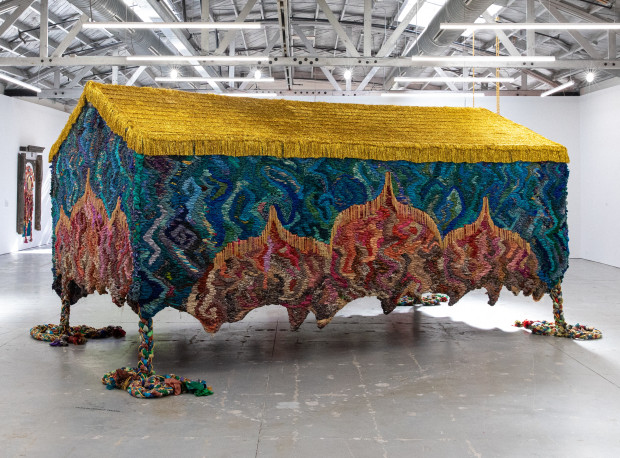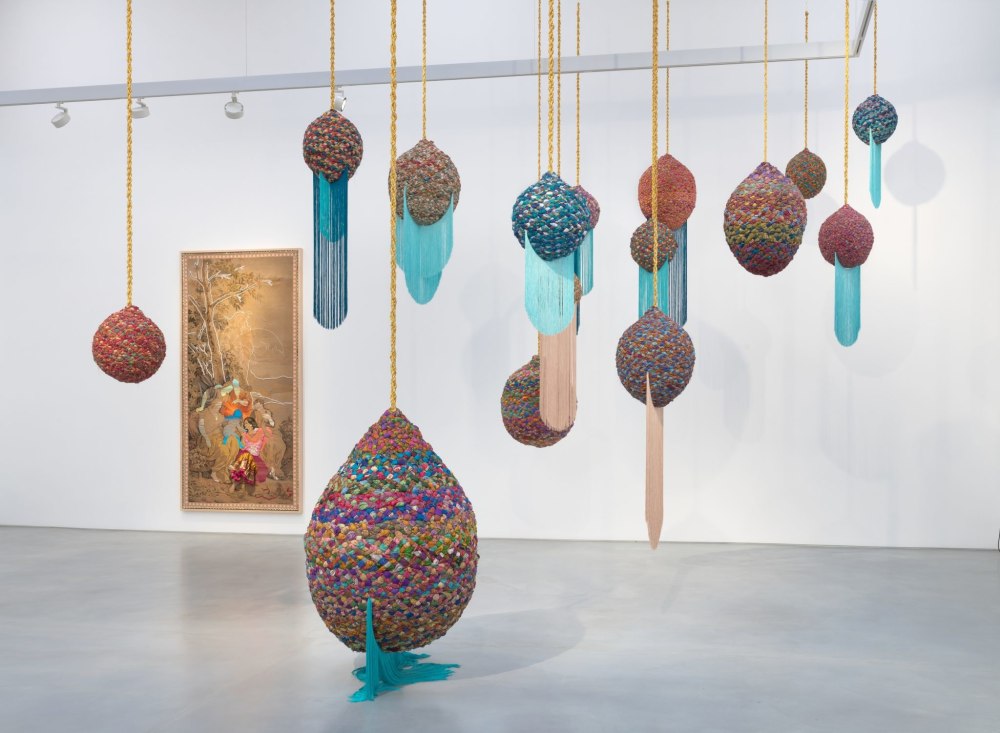

In the absence of power. In the presence of love at Roberts Projects, Los Angeles reimagines histories of migration and labour, sublimating colonial exploitation into a visual language of material abundance
The eclectic patterns, tasselled fabrics and intricate embroidery in Suchitra Mattai’s exhibition deliver a striking first impression. A handful of the artist’s largescale works dominate the three rooms of Roberts Projects housing her show. The most prominent of these is a group of massive, hanging soft-sculptures collectively titled phala (fruit) (all works 2023). These oversize ornaments are connected to the ceiling by silver chains and gold cords; some are spherical, and others are teardrop shaped. Each is wrapped in a mesh of saris woven so tightly it is almost impossible to tell where individual garments begin and end.
Throughout the exhibition, Mattai’s sumptuous works offer a rich array of hues: gold, mother-of-pearl, succulent green, peacock-blue and – most of all – a bold, sweet shade of magenta. Faithful to the maximalist aesthetic for which she is known, the artist employs vivid colours and high contrasts in ways that evoke a hot summer afternoon in Los Angeles – where she is now based after having lived elsewhere, including, importantly, in Georgetown, Guyana. In the nineteenth century her Indian great-grandparents were taken to Guyana as indentured workers by the British following the abolition of slavery in the South American colony. Drawing from Indian miniature painting and Guyanese carnival traditions in her work, Mattai reimagines histories of migration and labour, sublimating colonial exploitation into a visual language of material abundance.
Over time, one becomes acquainted with not only the works’ spectacular surface-level appeal but also their subtle quirks – frayed fibres, frenetic stitches – and the exhibition’s carnivalesque veneer gives way to the sense of being inside a cosy fabric-store whose clutter puts buyers at ease. Across from phala (fruit) in the main gallery, a seven-metre-long tapestry titled a cosmic awakening hangs asymmetrically on the wall. Here, again, saris tessellate in a shimmering mass, but there is something slack, unfussy and homelike in the way the work’s midsection sags. For all its lively colours and patterns, a cosmic awakening hangs like a well-worn, sloughed-off shawl. This mood of relaxed ease amid a frenzy of visual intrigue permeates the exhibition. Mattai’s patterns, textures and figurative tableaux beckon with their familiarity, enveloping viewers in signifiers of surplus and of leisure once denied to colonial labourers such as the artist’s great-grandparents, who inspired what the curatorial statement calls her process of ‘brown reclamation’.
Indeed, throughout the gallery, liberated brown figures appropriate the idle poses European colonial elites often adopted in eighteenth-century rococo paintings. In future perfect, Mattai takes a vintage needlepoint tapestry depicting Jean-Honoré Fragonard’s 1769 oil painting Young Girl Reading and retouches the girl’s face and hands with three shades of brown embroidery floss. To the French rococo painter’s upper-class tableau, Mattai adds her own ornaments: a magenta tassel on the seat cushion, freshwater pearls around the girl’s head and beads that spell the word ‘future’ across the pages of her book. Using the original image’s sumptuousness as imaginative fodder, Mattai draws up the iconography of a spectacular future made by and for people of colour.
Image courtesy of the artist and Roberts Projects, Los Angeles, California. Photo by Robert Wedemeyer.